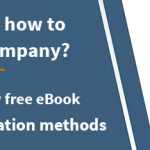When buying a company, it is important to know how to find the best company, and in order to do that, one must know how to first identify the ideal sector. In this article, we walk you through the 6 most important steps to finding that ideal company for you.
Choosing the ideal sector
“If I had an hour to solve a problem I’d spend 55 minutes thinking about the problem and 5 minutes thinking about solutions.” – Albert Einstein
All sectors have a tendency: to go up or down.
1- Analyze if the industry is concentrated (with only a few but large-sized players) or fragmented (many but small players). In those industries that are very concentrated, the leaders establish price. If it is fragmented, you have more possibilities of finding a leading candidate within a niche. Try to buy a company with a dominant position in that niche.
2- Analyze the structure of the industry and where it is going in the next 5 years. The ideal industry is one that will grow in the future and is fragmented – where the companies tend to be of small or medium size. Try to find one of these industries to which you can apply your experience and knowledge. In a fragmented industry, you avoid the presence of a giant that can disrupt the competitive landscape by, for example, changing the prices or conditions of the market.
YOU MIGHT ALSO BE INTERESTED IN, “HOW TO FIND AND BUY A COMPANY.”
3- Avoid industries in decline since they tend to hurt themselves with constant price reductions of the competitors to cover fixed costs and end up destroying margins.
4- Try to not enter industries that have intense competition, with low barriers to entry, high consumer negotiation power, and are subject to external factors that cannot be ignored (regarding regulation, technology, environment, fashion, etc.) The three key factors that determine the intensity of competition within an industry are the competition within the companies that are in it, the threat of new entrants, and the threat of substitute products or services. The level of competition in the sector is an indicator of the potential for high or low margins.
5- The size of the company you should buy depends on you and your experience. However, if you are not a “mega-executive” and do not have experience buying companies, it is best to buy a company that has a turnover between 6 to 12 million euros. That is an ideal size for your first operation because in those sizes, there tends to be a corporate structure to which you can make changes to significantly alter its ability to create value.
6- If you do not have a sector that you specialize in or do not know where to look, it is best to look in sectors that are fragmented based on geography or product line.
The ideal company
The ideal situation would be finding a company that is growing and that has a competitive advantage, that generates a healthy and constant margin, with profits above 15% of sales and with growth possibilities on various fronts.
In this ideal company, customers do not change and their concentration is low. Naturally, these companies are not cheap, but it is much better to buy a good company than to buy a bad one at a bargain price.

This article was written by Enrique Quemada, ONEtoONE President.














